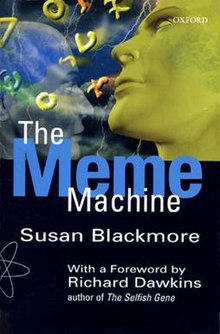
Back ماشین میم Persian A mémgépezet Hungarian La macchina dei memi. Perché i geni non bastano Italian
This article needs additional citations for verification. (April 2016) |
 | |
| Author | Susan Blackmore |
|---|---|
| Subject | Memetics |
| Publisher | Oxford University Press |
Publication date | 8 April 1999 |
| Media type | |
| Pages | 288 |
| ISBN | 0-19-286212-X |
| OCLC | 52855410 |
The Meme Machine is a popular science book by Susan Blackmore on the subject of memes. Blackmore attempts to constitute memetics as a science by discussing its empirical and analytic potential, as well as some important problems with memetics. The first half of the book tries to create greater clarity about the definition of the meme as she sees it. The last half of the book consists of a number of possible memetic explanations for such different problems as the origin of language, the origin of the human brain, sexual phenomena, the Internet and the notion of the self. These explanations, in her view, give simpler and clearer explanations than trying to create genetic explanations in these fields.
The idea of memes, and the word itself, were originally speculated by Richard Dawkins in his book The Selfish Gene although similar, or analogous, concepts had been in currency for a while before its publishing. Richard Dawkins wrote a foreword to The Meme Machine.
In the book, Blackmore examines the difficulties associated with the meme including its definition and how to spot one as well as the difficulties which arise from seeing it as being like the gene. She sees the meme in terms of being a universal replicator, of which the gene is but an example, rather than being like the gene itself. Universal replicators possess three key characteristics: high fidelity replication, high levels of fecundity (and therefore many copies) and longevity. She believes that these are earlier days for memes than genes, and that while memes have attained/evolved a sufficiently high level of these characteristics to qualify as replicators, they are not as effective replicators as genes by these key characteristics.
While others have accepted the possible existence of memes, they are sometimes seen as subordinate to genes. The author suggests that this is not the case now and that memes are independent replicators. Indeed, she suggests that memes may now in some cases be driving genetic evolution and be the cause of the abnormally large brain in Homo sapiens.[1] Blackmore notes that human brains began expanding in size at about the same time that we started using tools and suggests that once individuals began to imitate each other, selection pressure favored those who could make good choices on what to imitate, and could imitate intelligently.[1]
- ^ a b Blackmore, Susan (2000). The Meme Machine. Oxford University Press. pp. 75–76. ISBN 0-19-286212-X.